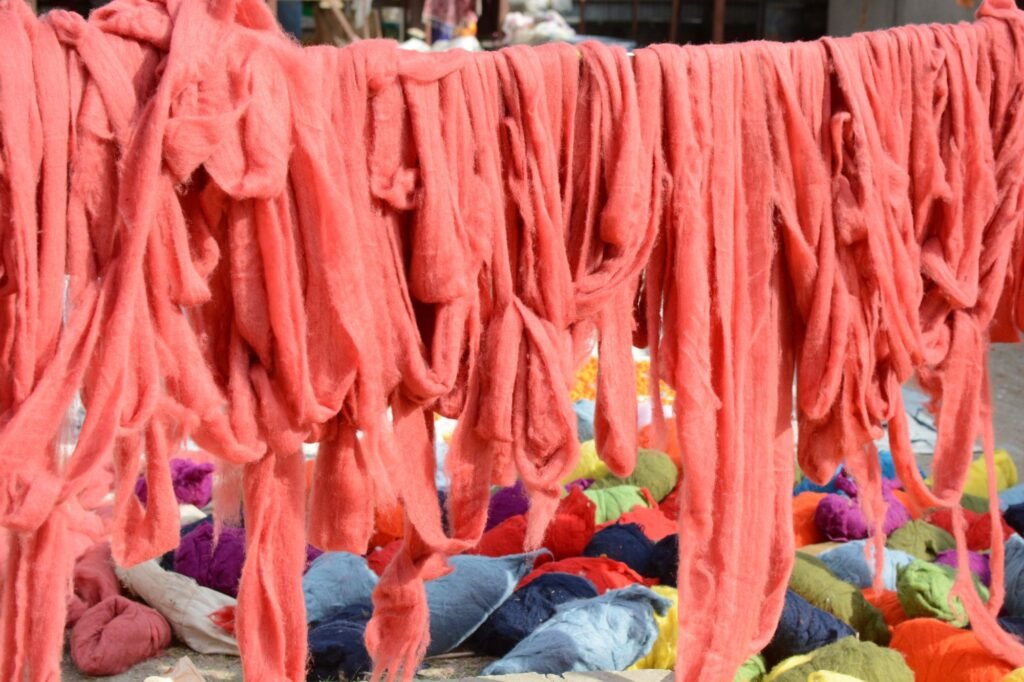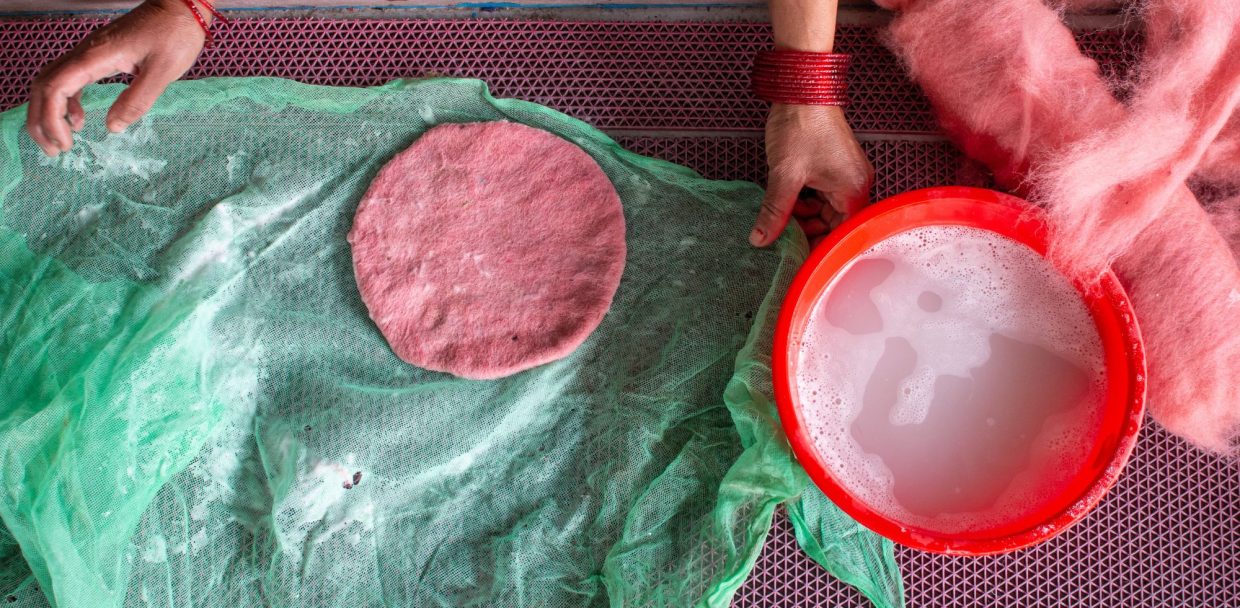Have you ever encountered a situation where you put on your beloved woolen garments or lay down a wool rug only to be greeted by an unpleasant odor? You know your wool item is clean, so why does it emit such a bad smell?
You’re not alone. Many people have experienced the same issue, particularly when wool is left damp for an extended period. It doesn’t matter if the liquid that caused the dampness is actually clean; the lingering smell can still be puzzling.
You’ve come to the right place if you’ve wondered why your wool sweaters or rugs develop an unpleasant odor. In this blog, we will delve into the various causes behind smelly wool and provide valuable tips on preventing and maintaining the freshness of your wool items around the clock.
These improvements make the introduction more informative and engaging, capturing the reader’s attention and setting the stage for the article’s purpose.

Cause of Smelly Wool- Lanolin
One of the primary causes of smelly wool is the presence of Lanolin, a natural waxy substance found in sheep’s wool. Lanolin, also known as wool wax, is secreted from the sebaceous glands of sheep and plays a crucial role in providing water-resistant properties to the wool fibers.
When wool becomes wet and is not dried properly, it creates a favorable environment for the growth of various microorganisms, including bacteria. Among the bacteria commonly associated with smelly wool are those belonging to the genera Corynebacterium and Staphylococcus.
Corynebacterium species, in particular, have been found to thrive in damp conditions and can contribute to the production of volatile compounds that give rise to unpleasant odors. These bacteria break down the lanolin present in the wool fibers, releasing byproducts that emit a foul smell.
Staphylococcus species are also known to colonize wool fibers and contribute to odor formation. These bacteria can produce enzymes that degrade organic matter, including components of lanolin, resulting in the release of volatile compounds responsible for the unpleasant smell.
The moisture accumulation within the wool fibers creates an ideal breeding ground for these odor-producing microorganisms. Factors such as high humidity, inadequate drying, or storing damp wool items can facilitate bacterial growth and the subsequent release of odorous compounds.
To mitigate the growth of odor-causing bacteria, it is essential to thoroughly dry wool items after they become wet. Adequate ventilation and airflow during the drying process help eliminate moisture, limiting the conditions that promote bacterial proliferation.
Furthermore, regular washing of wool garments and rugs using mild detergents can help remove any bacteria or organic residues accumulated over time, reducing the potential for unpleasant odors.
By understanding the role of Lanolin and the contribution of specific bacteria to the development of smelly wool, you can take proactive measures to maintain the freshness of your wool belongings.
Other Reasons Why Wool Might Smell
You might argue that not all wool garments smell. Well, that is because some garments may be super-washed, a cleaning process where the wool is washed enough for the dirt and debris to get removed along with a few remnants of the Lanolin.
When the wool is super-washed, the waxy substance is removed completely. If this main culprit is not present, it is likely for the garment to smell due to other reasons like:
Incomplete Drying
Improper drying and storing garments can lead to unpleasant odors, and wool is no exception. We’ve all experienced it at some point—during heavy rain or humid weather, clothes struggle to dry properly, resulting in a lingering bad smell.
With its moisture-trapping properties, Wool requires more drying time than other fabrics. If not dried thoroughly, bacteria can thrive, leading to a foul odor. To prevent this, ensure your wool garment is dried completely before storing it, allowing for proper airflow and eliminating any moisture that could contribute to odor buildup.
Wool is Prone to Insect Infestation
Wool fibers provide an ideal food source for insects, making them susceptible to infestation. Although such occurrences are relatively rare, it’s crucial to be aware of their potential risks. Insects can not only cause damage to your wool garments but also contribute to unpleasant odors.
To safeguard your wool items, it’s essential to implement preventive measures. Regularly inspect your garments for any signs of insect activity, such as small holes, webbing, or insect droppings. If you detect an infestation, promptly address it by employing appropriate pest control methods or seeking professional assistance.
Armpit Odor
It’s completely normal for individuals to have varying degrees of armpit odor due to biological factors. However, this natural body odor can transfer to your woolen garments, causing them to develop an unpleasant smell.
Typically, a thorough wash removes armpit odor entirely. However, the smell may persist in some cases and become attached to the wool fibers, requiring additional measures for effective odor removal.
To tackle this issue, consider using specialized odor-eliminating detergents or adding vinegar to the wash cycle, as vinegar can help neutralize stubborn odors. Additionally, ensure proper ventilation and airflow while drying the garment to expedite odor removal.
Absorbed Burnt Smell
If you spend time in a smoky environment, such as a smoking house, your woolen outfit will likely absorb the smell. Unfortunately, this burnt odor tends to linger even after leaving the smoky area.
To address this issue, there are several approaches you can take. First, air out the garment in an open area to allow fresh air to circulate and help dissipate the smell. You can also try using natural deodorizers like coffee grounds, which can absorb and mask unpleasant odors. Simply sprinkle coffee grounds over the woolen product and let it sit overnight before thoroughly airing it out. Repeat the process as necessary until the burnt smell is eliminated.
By following these steps, you can effectively combat the challenges associated with incomplete drying, insect infestation, armpit odor, and the smell of smoke, ensuring your woolen garments remain fresh and odor-free.
Removing Foul Smells from Your Woolen Items
Removing the smell can sometimes be a tiring job and might need some professional assistance as well. There are someway you can minimize the smell. Here are some tips to remove or minimize the foul smell.
Proper Sun Drying
Proper sun drying is a highly effective method to eliminate existing smells from woolen garments. When choosing this method, consider the weather and climate conditions, as they can impact the drying time. Select a sunny day with low humidity for faster and more efficient drying.
To begin, find a suitable outdoor area to hang your woolen garment. Ensure the area is clean and free from dust or debris that could transfer onto the garment. Hang the garment on a clothesline or a drying rack, ensuring it is spread out evenly to facilitate airflow and promote thorough drying.
Throughout the drying process, periodically flip the garment to expose all sides to the sun. This is particularly important for larger items like rugs, as it helps to dry them uniformly. Remember that the drying time may vary depending on the wool size, thickness, and prevailing weather conditions. Exercise patience and allow the garment to dry completely before removing it from the sun.
Manually Drying by Using a Fan
Manually drying woolen garments using a fan can be an effective alternative in areas with damp climates or frequent rainfall. This method helps accelerate the evaporation process and aids in eliminating moisture, reducing the chances of odor buildup.
First, position a fan before the wool garment, ensuring it is set to medium or high speed. Place the fan at a suitable distance to allow proper airflow without causing the garment to move excessively. This method may take longer than sun drying, so it’s important to exercise patience and allow sufficient time for the garment to dry completely.
While the fan is running, periodically flip the garment to expose different areas to the airflow. This ensures that all sections of the garment receive adequate ventilation and drying. Keep in mind that the drying time will vary depending on the size and thickness of the wool, so be diligent in monitoring the progress until the garment is thoroughly dry.
Baking Soda
Baking soda is a versatile and natural odor-absorbing agent that can help eliminate persistent smells from dry woolen rugs. Follow these steps to use baking soda effectively:
- Ensure that the woolen rug is completely dry before applying baking soda.
- Sprinkle a generous amount of baking soda evenly over the rug’s surface. Focus on areas that emit a strong odor.
- Allow the baking soda to sit on the rug for at least 30 minutes. During this time, the baking soda will absorb the odors trapped in the fibers.
- After the designated time, thoroughly vacuum the rug to remove the baking soda. Use a vacuum cleaner with a brush attachment to eliminate all traces of baking soda.
- If the odor persists, repeat the process until the foul smell is effectively neutralized.
- Once the rug smells fresh and clean, ensure it is stored in a clean, dry area to prevent further odor buildup.
Tea Tree Spray Solution
A tea tree spray solution is an effective method to minimize foul smells in woolen garments. Follow these steps for the best results:
- Combine two tablespoons of tea tree oil in a spray bottle with one cup of water. Shake the bottle well to ensure the ingredients are thoroughly mixed.
- Begin spraying the mixture evenly all over the smelly wool garment. Take turns spraying each side and ensure one side dries completely before spraying the other.
- The antiseptic properties of tea tree oil will help neutralize the smell and eliminate bacteria that contribute to the odor.
- Allow the garment to air dry completely before storing or wearing it again.
- For persistent smells, repeat the process until the desired results are achieved.
Professional Cleaning
If you’re uncertain about your cleaning and drying abilities or have large woolen products like rugs, it’s best to seek professional cleaning services. Professionals are trained to handle wool products carefully, ensuring they are thoroughly cleaned without any foul smell lingering.
Professional cleaners have access to specialized equipment that can effectively dry the woolen garments and eliminate any odor. Additionally, they can recommend suitable products to maintain the freshness of your woolen items.
Vinegar Solution
The vinegar solution method is particularly effective for addressing armpit smells in woolen garments. Follow these steps to use vinegar for odor removal:
- Mix one-fourth cup of vinegar with one cup of water in a container.
- Pour the vinegar solution onto the smelly area of the woolen garment, ensuring it is well-saturated. Allow it to soak for a few minutes.
- After soaking, hang the garment outdoors for approximately 30 minutes to air out and dry.
- After outdoor drying, wash the woolen garment using mild detergent and water. Soak it for 30 minutes to ensure the vinegar solution is thoroughly removed from the armpit area.
- Rinse the garment thoroughly to eliminate any remaining traces of vinegar.
- Allow the garment to air dry completely before wearing or storing it.
This method effectively removes armpit odor from woolen garments.
Natural Deodorant
You can use coffee grounds as a natural deodorant to eliminate or mask the burnt smell from a woolen product. Follow these steps:
- Pour freshly ground coffee directly onto the woolen product that smells burnt, ensuring the affected area is generously covered. The aroma of coffee grounds will help mask the burnt smell.
- Allow the coffee grounds to remain on the garment overnight, giving them ample time to absorb the unwanted odor.
- Repeat this process for several nights until the burnt smell is completely eliminated.
- Once the smell is gone, shake or brush off any residual coffee grounds from the garment.
- Ensure the woolen product is thoroughly dry before storing or wearing it again.
By following these specific instructions and tips for each solution, you can enhance their effectiveness in eliminating odors from woolen garments.
Does the Wool Smell Go Away?
One of the concerns we may have when dealing with foul-smelling woolen products is whether the odor will ever completely disappear. Let’s address this question.
The answer is yes. The foul smell in woolen products can be eliminated. With frequent washing, the lanolin present in wool gradually gets removed, significantly reducing the chances of persistent odor. However, it’s important to note that other smells, such as those caused by armpits, sweat, smoke, or external factors, may require additional measures for effective removal.
Lastly
The primary culprit behind the foul smell in wool is lanolin, a natural substance found in wool fibers. The good news is that as you wash your woolen items, the smell associated with lanolin gradually fades away. However, it’s worth considering that other factors might contribute to the odor in your woolen products.
Fortunately, for every problem, there is a solution. By following the preventive and removal techniques discussed in this article, you can effectively address and eliminate foul smells caused by external factors. With proper care and attention, you can ensure that your woolen garments and items remain fresh and free from unpleasant odors.
We hope this article has provided you with the information you were seeking. May it also help alleviate any concerns about encountering persistent smells in your woolen products, whether on your body or in your home.






